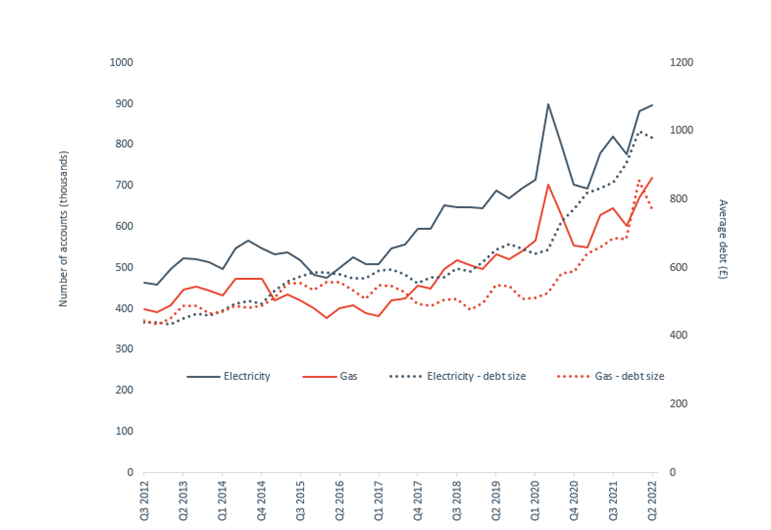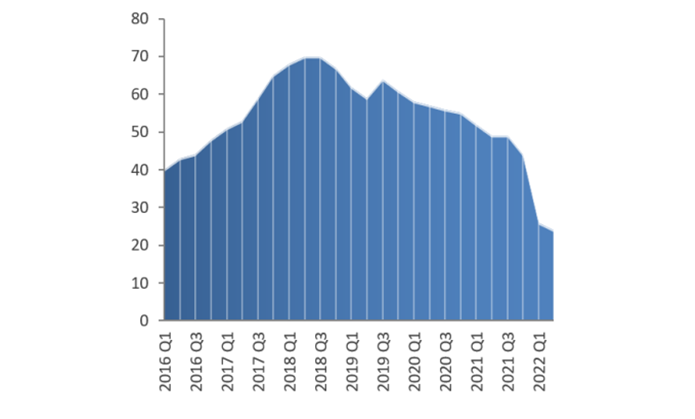A new report from Cornwall Insight and Complete Strategy – ‘Bad debt and energy suppliers: A systemic risk' – has shown domestic energy suppliers could be exposed to approximately £1.9bn of debt1, of which a significant portion could be unrecoverable. The amount of unrecoverable debt, known as bad debt, facing suppliers is increasing with the cost-of-living crisis leaving more households unable to pay their bills.
Without recovery of these debts, domestic energy suppliers are increasingly facing the prospect of very challenging financial circumstances, in particular on cashflow. The report warns that, with no action from policy or regulation, a worst-case scenario increases the risk of more supplier failures, potentially resulting in increased costs to consumers and a further exacerbation of the cost-of-living crisis.
Both the number of consumers with no arrangement in place to repay their debt, and the average size of that debt have increased throughout the last decade (Figure 1), with over £1.4bn2 of domestic consumer debt in Q222 for which there is no arrangement to repay the supplier.
In July 2022 eight major suppliers estimated that they would incur £1.3bn of bad debt across 2022-233. This is compared with the much lower levels of £585mn and £522mn of bad debt in 2020-21 and 2021-22. Bad debt is unfortunately only likely to grow, with the support provided by the Energy Price Guarantee (EPG) changing from £2,500 to £3,000 an average household. This will exacerbate the risk of supplier failures from April 2023.
Suppliers are allowed to make a margin of 1.9%4 within the average £2,500 EPG supported bill, and so the total implied profit for the market is £1.4bn. Not all of the £1.9bn of debt will be bad debt but, even under our conservative assumptions, the debt increases expected by suppliers could outweigh the allowed profits they might be able to achieve within the EPG.
Figure 1: Number of domestic accounts with no arrangement in place to repay debt to suppliers and the average size of that debt
Source: Data Ofgem
If suppliers do fail, the costs associated with the Supplier of Last Resort (SoLR) process and special administration for the exited suppliers will be passed onto consumers under current rules, only exacerbating the existing issues around paying for energy. Additionally, if in the worst-case, elevated levels of debt, and particularly bad debt, caused more suppliers to exit the market, the market runs the risk of no longer being truly competitive (Figure 2).
Figure 2: Number of domestic suppliers remaining active in the market
Source: Data Ofgem
Dr Matthew Chadwick, Lead Research Analyst at Cornwall Insight:
“The past two years have seen millions of households plunged into fuel poverty5 with many domestic consumers left unable to pay their energy bills, a situation which is set to get worse as government support is reduced. The knock-on effect of unpaid bills has the chance to be harmful to suppliers, many of whom were already working with very tight profit margins. The sad truth is, as bad-debt increases, so does the chance of supplier failure.
“The end cost of any exits will ultimately be borne by those paying the energy bills and without urgent action, suppliers and consumers could be left in a cycle of higher bills, increasing debt, supplier failure and ultimately even higher bills.
“A solution is not easy, and government and industry need to do what they can to make sure the most vulnerable are suitably protected. At the same time, there needs to be a clear path for suppliers to recover the increasing levels of bad debt they are incurring. In practice, this means that the costs of bad debt will either need to be carried by the suppliers or by customers who are in a position to pay. It is important that the industry finds a balance in which customer detriment is minimised, while reducing the overall risk to suppliers.”
Arthur Mitchell, Principal at Complete Strategy:
“We are in the middle of a period of extreme energy prices with customers and businesses struggling to meet their bills, and millions more households now in fuel poverty.
“Ofgem will need to find ways to protect current customers without putting undue pressure on future customers or energy suppliers from the impact of this debt. This is a very tricky balance to get right but will be essential if customer bills are to come down quickly when wholesale prices drop.”
Reference:
Ofgem have indicated that, in January – March 2022, ~1.9mn domestic consumers were in debt on their electricity bills and ~1.5mn were in debt on their gas bills. Even assuming those two groups fully overlap, that is ~1.9mn households who have faced an average energy bill increase of ~£712 since March 2022, generating an additional ~£1.35bn of potential debt in that period. Adding to this, the End Fuel Poverty Coalition estimate that ~1.6mn customers have entered fuel poverty in the last six months. If only 50% of those experienced equivalent challenges with rising prices, then the debt increase rises to ~£1.9bn.
BEIS Committee Inquiry - Energy pricing and the future of the Energy Market
BEIS Committee Inquiry - Energy pricing and the future of the Energy Market
Ofgem
National Energy Action

